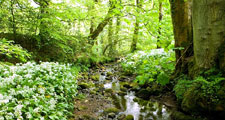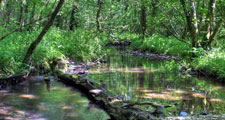Native Woodland in County Durham
Native Woodland
Native woods are composed of native trees and shrubs. They include ancient semi-natural woodlands (ASNW), secondary semi-natural woodlands and planted native woodlands.
Ancient Semi-natural Woodlands
Ancient semi-natural woodlands are native woods that have been in continual existence since at least 1600. In some cases, they form a direct link back to the original wildwood which established after the last Ice Age 10,000 years ago. Ancient woodlands are made up of plants that have arisen largely from natural processes although their composition and structure may have been affected by human activities like coppicing, pollarding, selective felling, or the grazing of livestock. The continuity of woodland over centuries makes many of these the most biologically complex and valuable of our woodlands.
Secondary Semi-natural Woodlands
Secondary semi-natural woodlands are woods that have arisen more recently through natural colonisation – on waste ground, abandoned pasture and heath, or clear-felled plantations. They often contain a high proportion of native species – but with a prevalence particularly in more recent woods, of ‘pioneers’ like birch. They are generally less biologically complex than ancient woodlands and don’t contain the less mobile plant and animal species that are slow to colonise new sites. They nevertheless often do have a relatively high nature conservation value. Recent woods in particular often contain herbaceous species and grasses characteristic of more open ground but in decline in managed farmland.
Planted Native Woodlands
Planted native woodlands are plantations which include a significant proportion of native species. The trees may be genotypes selected for their commercial or ornamental properties and may include UK native species not native to the locality, like Beech, or non-natives like Sycamore or Chestnut. Like secondary woodlands they are generally less biologically complex than ancient woodlands but functionally may be similar, and particularly if, having been planted close to older wooods, they have been colonised by native ground flora.
Native Woodland Types
The plant communities found in semi-natural woodlands vary across the county, reflecting changes in geology, soils, climate and the influence of human activity. Some woodland types are closely associated with one landscape type or natural area, others are more widespread in their distribution and show little change in their composition over a broad geographical range. Some, like wet woodlands, are associated with very localised conditions which may occur across a range of landscape types.
The base-poor soils which cover much of the county generally support woodlands dominated by oak. More diverse woods on the fertile soils of the lowlands give way to species-poor oak and oak-birch woods on the thinner, more acidic, or less fertile soils of the uplands. Oak-birch woods are also found locally in the lowlands on thin acidic soils over coal measures outcrops, and on pockets of free-draining glacial sands and gravels. Lowland Ash woodlands are found on the base rich soils of the limestone denes and escarpment, and upland Ash woods in the gorges, ravines and gills of the Pennines. Wet woodland communities occur across the county on wet or waterlogged soils. They are particularly characteristic of floodplains and valley floors, and the flat carrs of the lowlands, but also occur on wet flushes in drier woodlands and on the peaty soils in the uplands.
Native woodland types, classified using the National Vegetation Classification System (NVC), found in County Durham include:
- Lowland Ash Woodland (W8)
- Upland Ash Woodland (W9)
- Lowland Oak Woodland (W10)
- Lowland Oak Birch Woodland (W16)
- Upland Oak Birch Woodland (W11, W17)
- Birch Woodland (W4)
- Bay Willow Woodland (W3)
- Alder Carr Woodland (W5)
- Valley Fen Alder Woodland (W6)
- Alder Ash Woodland (W7)
- Yew Woodland (W13)
- Juniper Woodland – W19
- Hawthorn Scrub – W21
- Blackthorn Scrub – W22
- Gorse Scrub – W23
- Bramble Scrub – W24/25
Plant communities can vary within a few metres in a semi-natural woodland in response to changes in conditions and some woodlands may contain a number of different woodland ‘types’. A typical upland gill in the Durham Dales will cut down through sequences of limestones, sandstones and shales. A gill woodland may contain areas of ash woodland on base rich soils, alder-ash communities on flushed slopes, and areas of oak-birch woodland on acidic soils. Most of the county’s ancient semi-natural woodlands are in gills, denes and gorges, and many of these lie on the variable and thinly bedded strata of the carboniferous period. Where the solid geology is more massive, or masked by relatively homogenous drift, the composition of the woodland flora may be more uniform.
View Native Woodland Zone Map which shows the distribution of native woodland types in the county in the form of broad zones where particular combinations of woodland types may be found depending on localised ground conditions.
Existing plant communities are also heavily influenced by management – by grazing, coppicing, selective felling or planting. Upland oak-birch woodlands may be dominated by oak where they have been regularly coppiced in the past, or by birch if they have been clear felled at some stage. In grazed woods and wood pasture, past and present grazing pressures will heavily influence the ground flora. Many semi-natural woodlands have been modified by planting – either of native species or of commercial or exotic species – and this can mask their underlying type.
For further information on the typical structure and species composition of particular native woodland communities, distribution and guidelines on their management, and on suitable sites for new planting click on the links above or download the following pdf:
Native Woodland Types (PDF, 598kb)
Identifying Ancient Semi-natural Woodlands
- Ancient woodlands vary from large woodlands with a well-documented history to smaller, less obvious areas in larger plantations. There are a number of ways of finding out whether a tract of woodland is of ancient origin, or on an ancient site:
- English Nature maintains an Inventory of Ancient Woodland which shows the location of ancient semi-natural woodlands (ASNW) and plantations on ancient woodland (PAWS) sites. This inventory can be viewed in an interactive mapping environment on the MAGIC website. The inventory is by no means exhaustive and does not identify woodlands of less than 2 hectares.
- Looking at the ground flora can also identify ancient woodlands or ancient woodland sites. Where a number of key indicator species are found together, there is a high likelihood that the wood in which they occur is of ancient origin. Some common and easily recognisable species in County Durham include bluebell, dog’s mercury, primrose, ramsons (wild garlic), wood anemone and wood avens. These are particularly useful for identifying ancient woodland sites on fertile ground in the lowlands. Some upland and lowland Oak-birch woodlands lack many of these species and have a ground flora similar to adjacent areas of heathland. For a full list of species associated with ancient woodland sites in County Durham see Ancient Woodland Indicators.
- Looking at historical maps can also help identify old woodland sites.
- Place names on old maps can often give clues to the age and historical character of a wood. Hagg or Hag in Durham is commonly associated with older coppice woods as is Coppy. Individual species may also be reflected in the name: Oak (Oakes, Akk), Holly (Hollin), Ash (Esh, Ashes), Birch (Birks), Hazel (Hesle), Yew (Eu), Alder (Aller). ‘Black ‘ wood may refer to upland alder woods. The name Plantation usually indicates that a woodland was planted, but may also be applied to older woods that were absorbed into plantations during periods of improvement or modernisation.
- Location can also be an indicator – over much of County Durham ancient woodlands are typically found on steeply sloping features like denes and bluffs, the surrounding areas having long been cleared for agriculture. Ancient woodland sites can often be found on steep ground within larger, and later, plantations. They may also be found near parish boundaries as land close to the village was more convenient for agriculture.
- Ancient woodlands often have an irregular shape, either because of the shape of the natural features they follow or because they are a remnant of larger woodlands reduced by piecemeal enclosures or assarts. Ancient woodlands may also be associated with features like woodbanks and charcoal hearths or pits.



